Express delivery from Sicily to Budapest
There’s old-world glamour in spades on this three-day train journey from Sicily to Hungary.
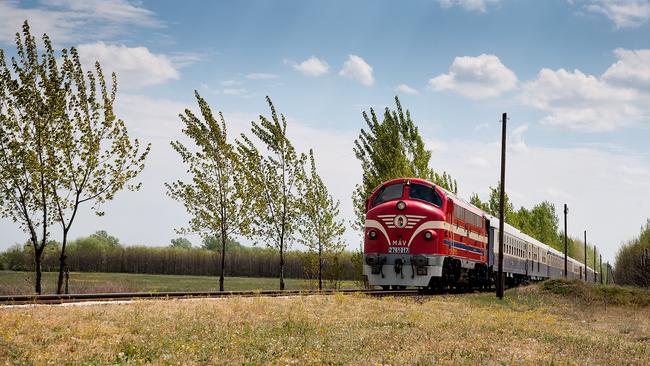
At the Italian port of Messina, the bow door of a ship is agape, waiting for a payload. It’s a standard roll-on, roll-off ferry, with one key difference: what’s rolling on is not cars and trucks, but a nine-carriage train.
The Golden Eagle Danube Express is three hours into a trip from Taormina, Sicily, to Budapest, and the only obstacle in its way is the Strait of Messina. Fortunately that’s one of the last three remaining train ferry routes in Europe (the others link Germany with Denmark and Sweden) and Golden Eagle has chartered this ship to get us on our way.
After a short delay on the quayside, to make sure the ship is perfectly lined up and to split the train in two, we rumble slowly into the cavernous hold, the two halves side-by-side. It looks just like any other ferry, except for the tracks inlaid into the deck.
This is an inaugural outing on the route for the newly refurbished Golden Eagle Danube Express, and there are not many of us aboard. To be precise, 17, who are now rattling about a deserted ferry for the 6.5km crossing to Villa San Giovanni on the mainland. It’s a blowy day so a fellow traveller and I chance our arm by knocking on the bridge door. Without much hesitation the captain, Francesco Straffacaci, welcomes us in cheerily. He likes a chat, which prompts us to ask who’s driving, given we’re on a busy shipping route; I can see five other ferries and three container leviathans around us. He casually waves in the direction of another officer.
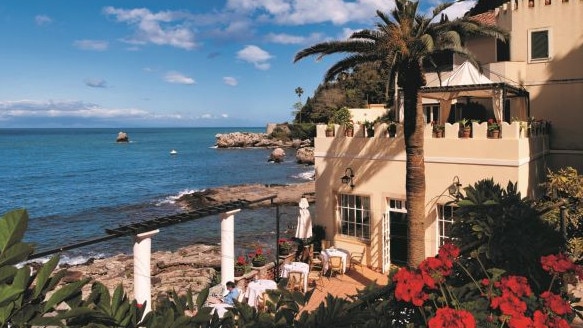
As great as the view of Etna is from the bridge, it’s something of a relief we are ushered out just before we reach port. We head back down to the train for disembarkation and I find myself in the white-table-clothed restaurant car with a cup of coffee. But as we trundle slowly off, the crockery laid out for lunch starts rattling frantically before a series of thumps and judders brings us to a halt. A posse of dockers runs to peer under the carriage. It transpires that, because of a spring tide, the ship and the off-ramp are not aligned, and the restaurant car has grounded on the lip of the bow. After the ship’s ballast tanks are filled to lower our level in the water, we inch off the ferry for a quick inspection for damage. All intact. Phew.
We have spent the night before at the Belmond Villa Sant’Andrea, a pearl of a five-star hotel in Taormina. The seaside town is heaving. Luckily, the 68-guestroom hotel is tucked out of the way at the bottom of the cliffs. Sitting on the terrace, listening to the sea rake the shingle down the private beach, is about as tranquil as Taormina gets. For a glimpse of the madness, take the shuttle up to Villa Sant’Andrea’s sister hotel, the glorious Belmond Grand Hotel Timeo, beside the Greek amphitheatre in the centre of town, for a drink. The cost of a G&T will blow you away, but so will the gobsmacking view of Etna from Timeo’s Literary Terrace, so called because writers loved it; Truman Capote was a guest for two years and DH Lawrence wrote Lady Chatterley’s Lover up there.
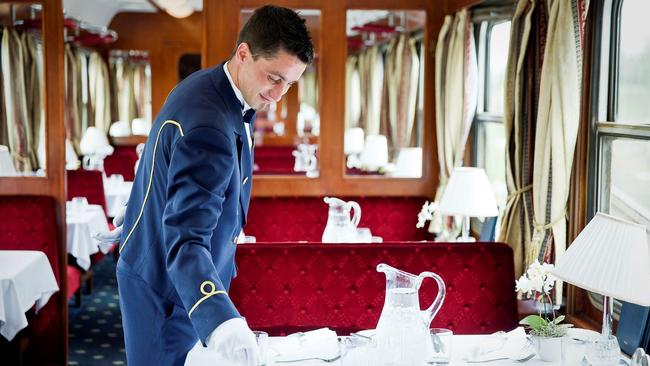
If Timeo appealed to the literati, Villa Sant’Andrea was always about the glitterati, its privacy attracting Elizabeth Taylor, Richard Burton and their like after it was turned into a hotel in the 1950s. I stay in the oldest part, originally a family home built in 1830, in a tasteful buttermilk-coloured room with a marble bathroom looking out over the gardens. This hotel is all about old-school hospitality and charming service, I discover over our welcome dinner that evening. The 17 of us and tour leader sit down to a delicious spread of San Daniele ham with melon, followed by lemon confit chicken and smoked mash.
The next morning we board the blue-and-white liveried train under a full moon at 5.30am. By early afternoon, now on the mainland, a nap is in order. Time to check out how comfy my bed is. I’m in one of the roomy new superior deluxe cabins. There is an L-shaped sofa, which converts to a kingsize bed, plus a table with two chairs, ample cupboard space, airconditioning, Wi-Fi and USB ports.
The acre of fake wooden panelling is a bit chain hotel, but I can forgive this for one simple reason: the cabin has an ensuite with a good shower, L’Occitane toiletries and my own loo, so no weaving down the corridor in my jimjams in the middle of the night. Given that most of my fellow guests are of retirement age — five couples and seven singletons, comprising 13 Americans, three Brits and a Singaporean — I’m sure I’m not the only one relieved (ho ho) by this.
We are speeding along the north coast of Calabria, whizzing in and out of tunnels, the sea having a competition to out-azure itself each time we emerge back into sunshine. The afternoon passes in a blur of beaches and olive groves before we cut inland through a wide valley south of Cassano all’Ionio to drop down on to the Ionian coast.
We are heading for Bari, our first stop, which we reach at 6.30pm. Now, I’m sure Bari is a delight, but on the basis of a 1½-hour whistle-stop tour after night has fallen, I can’t really vouch for that. What I can say is that we visit the 11th-century Basilica of Saint Nicholas, which has a beautiful gilt wooden ceiling, and admire the ramparts of the Castello Svevo. There’s just time for a quick stroll around the old town and an enormous dinner in a restaurant called Giampaolo before heading back to the train.
The next morning we are tracking north along the coast, about to enter the Molise region. As I push up the blind the dawn is turning the sky above the Adriatic a fiery peach colour. I lie in bed and watch the showstopper of a sunrise until we gently come to a halt in a station, where I fear the early-morning commuters of Campomarino can see me in bed and I have to hide under the covers.
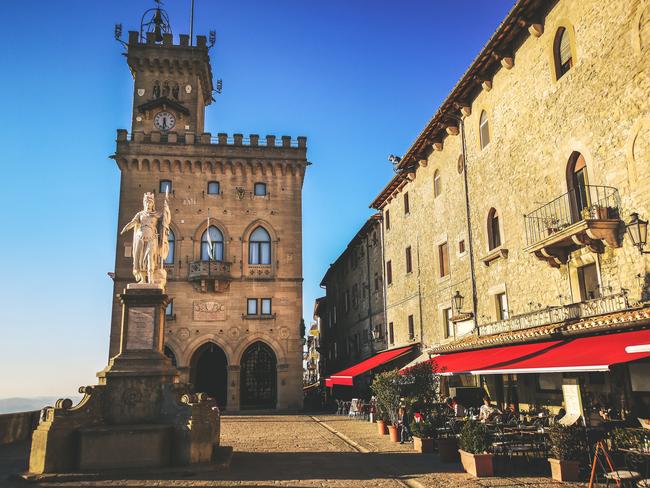
The coast notches up the gorgeousness around Ancona, where the wide sandy beaches and fishermen’s huts over the water urge me to pull the emergency cord so I can explore them. But we roll on north to Rimini, to disembark for a drive to San Marino, 50 minutes inland. San Marino is perched on Mount Titano, a 740m-high rock in the foothills of the Apennines capped by the three towers that appear on the republic’s flag. The views are monumentally beautiful, lush, green and vast. You can even see Croatia on a clear day.
The country used to be a tax haven that ended up on money laundering watch-lists, but has put its house in order in a bid for EU membership. I assume some of the riches generated during that period were spent on gussying up the place; it looks almost too perfect, like a toy town that has been restored to within an inch of its life.
We start beside two Skoda Superbs, the official cars of San Marino’s Captains Regent (its co-presidents). They are parked on Piazza della Liberta, in front of the bijou, 19th-century Palazzo Pubblico, the seat of government. We wander up through the tiny pedestrianised streets, past the neoclassical basilica to the immaculate 11th-century Guaita fortress, the oldest of San Marino’s three towers. From the ramparts you get a great view of the other two, although they’re always competing with their sensational backdrop. The walk ends with an excellent meal of pasta with courgette flowers and then beef fillet in Righi, an atmospheric, Michelin-starred restaurant back in Piazza della Liberta.
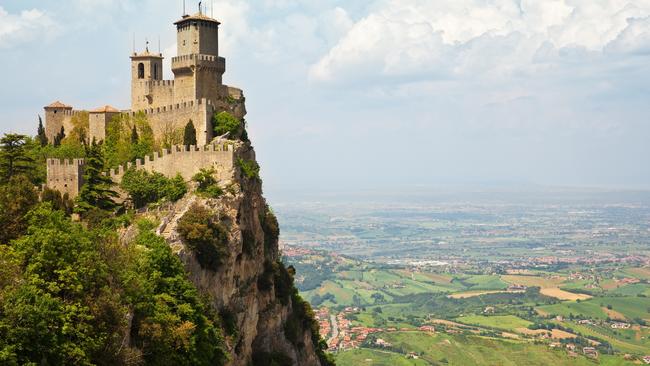
Our first-rate lunch throws the hit-and-miss offerings in the train’s restaurant car into sharp focus. Dinner comes with a choice of two dishes for starters and mains. For the first evening it’s a filo basket filled with pork and spicy sausage or a roasted tomato, then roast duck or ratatouille with rice. All of these are competent, if unremarkable. On the second night, the main is braised beef so chewy it reminds my dining companion of Peperami. I luck out by choosing the mushroom stroganoff, which is fine. Overall, the Hungarian chefs never quite deliver on the deliciousness suggested by their menu descriptions.
By the next morning we’ve slipped into Slovenia, and slipped into autumn too. After San Marino’s dazzling sunshine, we wake up in woodland where the leaves are changing, mist lurks in the valley bottoms and the sky is battleship grey.
At 7.57am sharp we pull into the little gem of Ljubljana. As we walk, our guide points out the elegant secession architecture — a Germanic take on art nouveau of which Klimt was the key exponent — and leads us via the city’s main Preseren Square to the farmer’s market, which is replete with newly harvested goodies, including showy, shiny red cabbages, gleaming chestnuts, an array of mushrooms and berries, and the splendid (even at that time of the morning) Broken Bones gin.
From there it’s a scoot up the funicular to Ljubljana Castle and a boat trip down the Ljubljanica river. We’re back on the train at 12.30pm for lunch.
Our roaming is coming to a close. We still have nine hours of lovely countryside to navigate before we can check into the Kempinski Hotel Corvinus in Budapest for our final night, though. Leaving Ljubljana we follow the Sava valley, a wooded limestone gorge with churches perched on top of hills, before the landscape flattens out into farmland. At the border we swap locomotive, from electric to a bright red, 60-year-old vintage diesel workhorse (a treat for the railway buffs).

Once in Hungary we’re into the Orsegi National Park, with its low hills and woodland, and hay rolls sitting in parched fields. In the soft light of dusk, it looks like the agrarian dream. Darkness has fallen and we’re all gathered in the bar for some live music by the time we skirt northeast along the shore of Lake Balaton.
We arrive at Budapest at 10.30pm. It has been a journey of 2200km and 3.3 nautical miles in a mere 64 hours. It’s astonishing what you can pack into a fraction under three days. But actually one of the highlights has been simply watching Europe’s scenery unfold, which demands you be in the moment, not glued to social media or a Kindle. If that’s not the definition of relaxation, I don’t know what is.
Amanda Linfoot was a guest of Golden Eagle Luxury Trains.
The Times
-
In The Know
Golden Eagles Luxury Trains’ next Taste of Italy journey departs on October 14, 2020. From $US4095 ($5870) a person, single or twin-share. All meals and drinks, excursions, porterage, transfers and gratuities are included.

To join the conversation, please log in. Don't have an account? Register
Join the conversation, you are commenting as Logout